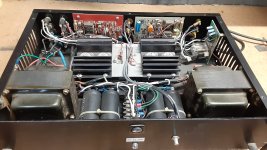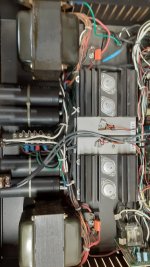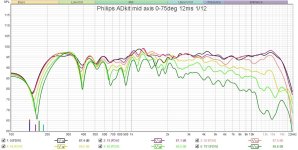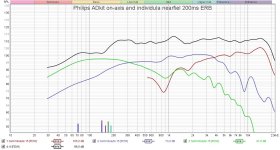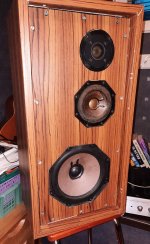techtool, planet10 - I keep the TI-59 and a decade-later TI-95 in a drawer.
I recently bought a Casio FX-9750GIII to see how calculators have improved. The UI is much better, but the TI-59 could do many of the same things 45 years earlier.
Of course, the reality is that I solve math problems by writing computer software. 🙂
Ed
I recently bought a Casio FX-9750GIII to see how calculators have improved. The UI is much better, but the TI-59 could do many of the same things 45 years earlier.
Of course, the reality is that I solve math problems by writing computer software. 🙂
Ed
i have a nice RPN calculator -- it's on my iPhone. I have run through 3 HP41's
50 years ago I bought a little Bowmar calc for my job. When the battery was low it was awful. Shoulda bought a TI. I think that the first HP41 I bought was almost $300 and them's real dollars 45 years ago.
I think it was circa 1980 or 1981 that I built a Heath IG-18.
50 years ago I bought a little Bowmar calc for my job. When the battery was low it was awful. Shoulda bought a TI. I think that the first HP41 I bought was almost $300 and them's real dollars 45 years ago.
I think it was circa 1980 or 1981 that I built a Heath IG-18.
Wake up Grandpa and give him a chocolate-chip cookie ...
Built a Heathkit AR-14 FM Receiver to drive Utility Advents circa 1971. Massive 10W/Ch (internet photos copy)

Singletons and single polarity supplies are back in fashion, so maybe I can make a ... no,no, calm down.
Also built a Heathkit Digital Proportional 5-Channel Radio Control System (for model airplanes) with Kraft style servos circa 1971. (internet photo copy)

No, that is not me below, and I did not build that thing ... nope. (internet photo copy)

David
Built a Heathkit AR-14 FM Receiver to drive Utility Advents circa 1971. Massive 10W/Ch (internet photos copy)
Singletons and single polarity supplies are back in fashion, so maybe I can make a ... no,no, calm down.
Also built a Heathkit Digital Proportional 5-Channel Radio Control System (for model airplanes) with Kraft style servos circa 1971. (internet photo copy)
No, that is not me below, and I did not build that thing ... nope. (internet photo copy)
David
Anyone here ever go to a Library Disco 50 ish years ago. Manhattan in the Barbizon Plaza Hotel, Atlanta, Denver, Syracuse and Pittsburgh.
By today’s standards quite a tame sound system. Four 15” woofers and matching 90 degree horns with compression drivers. As time went by they got powered by Crown DC300 amplifiers. First turntables were Duals as the direct drive turntables weren’t quite available at first. So felt slip mats were used to jiggle the discs.
Later on floor mounted subwoofers were added.
By today’s standards quite a tame sound system. Four 15” woofers and matching 90 degree horns with compression drivers. As time went by they got powered by Crown DC300 amplifiers. First turntables were Duals as the direct drive turntables weren’t quite available at first. So felt slip mats were used to jiggle the discs.
Later on floor mounted subwoofers were added.
50 years ago I built a power supply for my Eico transceiver. I had blown the power transformer on the original supply, somewhere there is a picture of the old supply with a mil-surplus transformer. I guess previous to that I had built a regenerative short wave receiver, a single tube (6DQ6B) transmitter, a 6 meter transmitter (I still have a half-dozen 6360 twin tetrodes), a 6 meter converter etc...oh, a fixed up BC348 receiver power supply.
The Knight stuff, out of the Allied Electronics catalog was certainly competitive with fledgling Heath in that era. I think I had memorized the Allied catalog! Various websites have archived the catalogs.
I built some Knight kits and Heatkits. But I built lots and lots of Dynakits, both tube and solid state.
Pretty much every model they ever made, multiple times each.
Pretty much every model they ever made, multiple times each.
Last edited:
One of the first things I built. It was a kit. Worked pretty well. Long gone, now.
I used it on my early attempts at recording on my Teac 3340S 4 track.
https://worldradiohistory.com/hd2/I...X/70s/79/Poptronics-1979-08-OCR-Page-0062.pdf
I used it on my early attempts at recording on my Teac 3340S 4 track.
https://worldradiohistory.com/hd2/I...X/70s/79/Poptronics-1979-08-OCR-Page-0062.pdf
I use the HP48+ app. Great HP48 emulator for the iThingy.i have a nice RPN calculator -- it's on my iPhone.
I was born 50 years ago this month. So 50 years ago I wasn't up to much. It's about 45 years since I started exploring the power dissipation limits of resistors, i.e., letting out their magic smoke. 🙂
Tom
I had an HP11C back in grad school days in the late 80s. I LOVED it once I got used to the RPN. But somehow it disappeared along the way. Used it to program things like net present value (I was a resource economics and policy student). I still have the case and the manual. Obviously hoping it will show up again somehow (against all reason). Many years ago my uncle worked for HP (in the early days) and came home with one of, if not THE, first hand-held calculators. Absurdly simple but we were all in awe.
Hp was a little late to the party.
https://edtechmagazine.com/k12/article/2012/11/calculating-firsts-visual-history-calculators
https://edtechmagazine.com/k12/article/2012/11/calculating-firsts-visual-history-calculators
Built a quasi-complementary stereo power amplifier with 2N3055 output transistors from scratch based on a design in I think Alta Fedelta. I guess late 1975 early 1976. In any case an Italian electronics magazine. (Those magazines were great, and I had more than a working knowledge of Italian at the time.)
Some really bad transistorized passively equalized phono stages of my own design. I was quite happy with them at the time - gave me access to my first magnetic cartridges. I distinctly remember they sounded better than the inexpensive commercial pre-amp I bought and returned within days. I really had no idea what I was doing, but I wasn't all that critical either.
Some really bad transistorized passively equalized phono stages of my own design. I was quite happy with them at the time - gave me access to my first magnetic cartridges. I distinctly remember they sounded better than the inexpensive commercial pre-amp I bought and returned within days. I really had no idea what I was doing, but I wasn't all that critical either.
Well...not very late. I clearly don't really recall the first hand-held built (which this says was TI in 1967) as I was probably 6y.o. at the time. But the HP my relative brought (around 1969 or 1970, maybe earlier) was pretty close in timing. I think what Uncle Pete brought was a prototype, but again I was pretty young at the time. He also had a convertible corvette around the same time as I recall, with which I was a bit more impressed... In any case it was VERY earlyHp was a little late to the party.
https://edtechmagazine.com/k12/article/2012/11/calculating-firsts-visual-history-calculators
I had a whack at repairing a Monroe Calculator I found on the curb by a typewriter shop. About 1970. It would actually multiply and divide, but not print out. I had three hulks, could make no progress. Driven by an electric motor, totally full of gears. I got to operate one at my Dad's workplace about 1962. He was an accountant.
1969 I drove 15 miles to the university at 3 AM to use a 8 digit calculator with nixie tube readout. Chemistry 100 lab forced us to do an experiment that required 4 digit accuracy. No slide rules.
Three years later my boss on a thunder research project had a HP30? calculator. Add subtract, multiply & divide, actual sines and logs if I remember right. Only $340, about 220 hours pay I was making as a lightning observer/cable layer/truck driver/mechanic. Amazing. He was using it to calculate lightning paths from the thunder recordings (9 mikes over 300 acres of prarie) since it was such a PITA to program the computer the Space Science dept had. University had just changed from IBM Fortran to Burroughs for the main computer. Nobody cheap could cope with the required Algol either.
1969 I drove 15 miles to the university at 3 AM to use a 8 digit calculator with nixie tube readout. Chemistry 100 lab forced us to do an experiment that required 4 digit accuracy. No slide rules.
Three years later my boss on a thunder research project had a HP30? calculator. Add subtract, multiply & divide, actual sines and logs if I remember right. Only $340, about 220 hours pay I was making as a lightning observer/cable layer/truck driver/mechanic. Amazing. He was using it to calculate lightning paths from the thunder recordings (9 mikes over 300 acres of prarie) since it was such a PITA to program the computer the Space Science dept had. University had just changed from IBM Fortran to Burroughs for the main computer. Nobody cheap could cope with the required Algol either.
Last edited:
- Home
- Loudspeakers
- Multi-Way
- geezers - what did you build 50 years ago?
